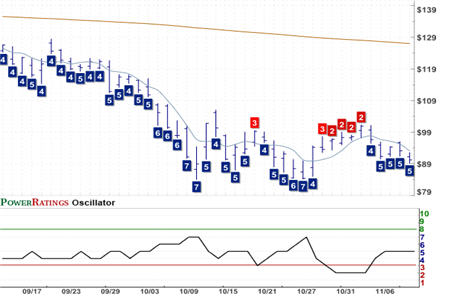BattlePlan Trade of the Week: Selling the SPYs
The majority of the trades we’ve taken in the TradingMarkets BattlePlan over the months have been long trades. However the fact that stocks have been under pressure for so long means that there are fewer and fewer quality pullbacks for us to choose from.
What do I mean by quality pullbacks? The heart and soul of our stock trading strategy is to buy stocks that are trading above the 200-day moving average and have pulled back by a significant amount. There are two situations in which this trading strategy will be somewhat less productive. One is when stocks are in full-momentum mode – as occurs when markets are running away to the upside or downside with little pause. The other situation develops when a significant majority of stocks are trading below the 200-day moving average, thus limiting the number of potential trading candidates.
Recent weeks in the market have seen evidence of both – particularly when the bear market that has brought so many stocks below their 200-day moving averages begin rewarding momentum by selling off for multiple consecutive days.
One strategy we have added to the BattlePlan in recent days is to sell short exchange-traded funds. Particularly appropriate when markets become overbought below the 200-day moving average, selling short ETFs of the major market indexes such as the Nasdaq 100 and the S&P 500 have given us the opportunity to apply the same basic principles of buying low and selling high (here selling short high and covering low) to the world of ETFs as to stocks.
This week saw us taking a number of short ETF trades in the BattlePlan. One of the bigger signals we received last week was a trading opportunity in the S&P 500 Index SPDRS, SPY.
(
SPY |
Quote |
Chart |
News |
PowerRating).

Here we looked for instances when the SPY’s 2-period RSI had closed above 70. As the SPY closes higher we add a fractional unit to our position. For example, if we were to commit up to three units on the trade, we would go short one unit on the first close, a second unit if the SPY close higher, and a final, third unit if the SPY closed higher still.

One caveat to this is that we tend to wait for the second day of an ETF being overbought, rather than just the first day. This helps ensure that we have a fund that is deeply overbought and more likely to respond when the inevitable selling resumes.
In our model portfolio, this short trade worked out very well. One unit short in the SPY on October 31 at 96.83, a second unit short on November 3 at 97.11, and a third unit short on November 4 at 100.41. Our exit was a show of weakness – a close below the 5-day moving average, which we got on November 5, with a close in the SPY at 96.19.
If your trading has gotten tougher over the past weeks and months, then consider a free trial to our TradingMarkets Battle Plan for Stocks. Every day we’ll provide you with incisive, before-the-bell commentary and analysis on the day’s markets to help put your trading in context. We’ll give you suggested entries and exits for trade opportunities that may be only hours away. And we’ll give you what many other people can’t: model-driven percentages so that you know the historical win rate going back to 1995 for every single trade idea—
